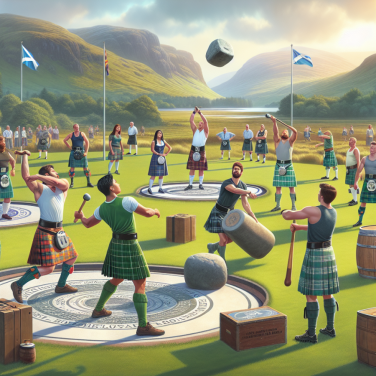The Athletic Prowess and Cultural Festivities of Scotland's Highland Games
The Highland Games in Scotland embody a rich mosaic of athletic excellence and cultural celebration. This fascinating tradition, deeply rooted in Scottish history, showcases the physical strength and skill of the competitors while radiating the charm of Scotland's cultural heritage.
An essential feature of the games is the demonstration of athletic prowess through events like the caber toss, where participants showcase their strength by flipping a tall, hefty log end over end. The stone put, akin to the shot put, demands both technique and power, as athletes hurl a heavy stone as far as possible. Another crowd favorite is the hammer throw; competitors swing a heavy weight on the end of a stick, seeking to achieve the longest distance. These feats of strength are not just for individual glory; they celebrate the historical training of Scottish warriors.
But there's more to the games than the competition of strength. The Highland Games are also a cornucopia of Scottish cultural festivities. The sound of bagpipes fills the air as pipe bands in colorful tartans compete in musical displays that are both stirring and poignant. Highland dancing is another key element, with dancers performing traditional dances like the Sword Dance and the Sean Triubhas, displaying intricate footwork and agility that are judged not only for technical proficiency but also for poise and grace.
The attire worn at the games, including kilts and other traditional Highland dress, adds to the vibrant spectacle. The tartan patterns represent different Scottish clans, symbolizing the country's rich clan heritage and the pride of Scotland's people.
Visitors can also explore a variety of tents and stalls offering Scottish foods such as haggis, shortbread, and Scotch whisky, which provide a taste of the culinary traditions that have been passed down through generations. Meanwhile, craftspeople display their skills, creating traditional Scottish items like tartan, tweed products, and other crafts that represent the artistic legacy of the nation.
The Highland Games extend beyond mere sport; they serve as a gathering point for communities, a place where Scots connect with their heritage and where visitors can get a true sense of Scotland's vibrant culture and warm hospitality. By engaging in the spectacle of the Highland Games, spectators are not just witnessing a series of athletic competitions—they are being immersed in a centuries-old cultural festival that continues to be an enduring source of pride for the Scottish nation.
Read also:
The Thrill of Campdrafting: Australia's Cowboy Legacy
Exploring the Roots and Revelry of Highland Games Heritage
The Highland Games are perhaps one of Scotland's most enduring and vivacious traditions, attracting visitors from around the world to witness a blend of athletic competition, cultural display, and community gathering. These storied events are celebrated with great enthusiasm, combining feats of strength, music, dancing, and a hearty sense of Scottish pride.
Tracing their origins back to the mists of time, the Highland Games are believed to have roots in the ancient Celtic society of Scotland, with a primary purpose of testing the might and skill of the clan warriors. Some of the traditional events, like the caber toss—a spectacle wherein athletes flip a long, tapered log end over end—take their inspiration from the practical tasks of everyday life in the Scottish Highlands. Other events such as hammer throwing and stone putting are said to have evolved from training exercises that developed strength and battle readiness among the clansmen.
As time went by, the Highland Games grew to incorporate more ceremonial and festive elements, such as music and dance, most notably the bagpipes and the intricate choreography of highland dances. These cultural components wove together the competitive and social aspects of the Games, ensuring their continuity even as Scotland changed through the centuries.
Clan gatherings, once a means to demonstrate kinship and solidarity, now also honor ancestral traditions at these Games. Each participating clan flies its tartan with pride and may even sponsor certain events or competitors, seeing it as a continuation of their historic patronage of the arts and athleticism.
The modern Highland Games, while still fiercely competitive, also serve as an invaluable repository of Scottish culture. From the tossing of the caber to the gracefulness of the sword dance, they preserve ancient practices that might otherwise fade into obscurity. The Games perform a dual role, both safeguarding heritage and evolving it with contemporary vigor.
The heavy events, the most recognizable facet of the Games, include the aforementioned caber toss, the stone put (similar to the shot put but with a large stone), the Scottish hammer throw (where a round metal weight is thrown while holding onto a handle), and the weight for height (where competitors throw a weight over a horizontal bar). These events are a labour of love and respect for traditions that date back centuries, and they demand a blend of raw strength and fine-tuned technique.
Another significant part of the Highland Games' heritage is the role of the Chief of the Games.




